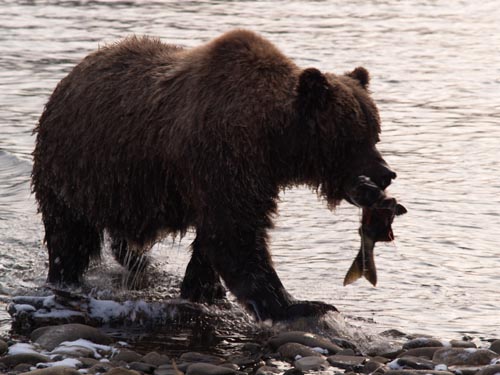
It isn’t often that bears and icicles get to hang out together; usually bears are in hibernation mode when icicles like to grow. But a unique set of circumstances in northern Yukon sees grizzlies fishing in warm(ish) water each fall when the air is below zero, creating body icicles like the ones pictured here.
You and I will likely not ever see this except through photos. The Wilderness Preserve and Habitat Protection areas where Fishing Branch River flows are only accessible by helicopter, dogsled or snowmobile (besides the fact that they’re protected).
The park the river flows through is officially named Ni’iinlii Njik, after the “river where salmon spawn” or Fishing Branch River as it is known on maps. This is a special area to the Vuntut Gwichin First Nation and the area became a Territorial Park in 1999 out of the nation’s land claim settlement.

I learned about Fishing Branch from chatting with Gord Macrae, good neighbour, accomplished outdoorsman and Superintendent of Klondike Region for Yukon Parks. Actually what happened was that I was chatting on the street with his partner and asked in passing, “Where’s Gord these days?”
“Oh, he’s up at Fishing Branch for a week,” she replied, “taking photos of grizzlies with icicles all over them.” This man has one of the best jobs, I thought.
When Gord returned, I asked if he’d be willing to share some of the 300+ photos with The Ice Cubicle.
He was, which is a gift for the rest of us since this endangered species is harder to find.
Gord also wrote out some information on the area.
“Because the salmon run at Fishing Branch is very late, the bears must swim and dive for fish in cold temperatures and snow, and are often covered in ice and snow – making for a very unusual look and a unique photography experience.
Since the area became a Territorial Park, it has been managed through a co-operative effort between the Vuntut Gwechin and the Yukon Government and a third party, a commercial venture jointly owned by the Vuntut Gwechin called “Bear Cave Mountain Eco-Adventures.” This is a commercial bear viewing operation that takes place from late September through October. A limited number of guests are guided to view grizzly bears as they hunt and eat late spawning chum and coho salmon, just before hibernation.
The number of people who are allowed to do this at any one time during the bear viewing season is 5 including the guide (according to the management plan for the Park). This very limited restriction is meant to protect the bears and the salmon.
A part of the viewing operation is a monitoring project put together by a masters student to determine whether or not commercial bear viewing has any effect on bear behaviour, especially the eating behaviour – i.e. we do not want the commercial operation to negatively affect bears that are attempting to put on weight and fat prior to hibernation.

There were four of us who went, 2 from Yukon parks, one contractor planning to fabricate interpretive panels, and the guide, Phil Tympany. We flew in on Oct 17 and out to Dawson on Oct 24.”
Gord also explained that the viewing area is always in the same place, so the grizzlies can become used to the fact that that spot has humans showing up from time to time. This allows the bears to choose their distance, instead of having to change their location because of humans moving deeper into grizzly territory.
This version of wilderness tourism makes so much sense. It’s the wisdom of the Vuntut Gwichin and Yukon Parks rangers and wilderness guides who care about keeping the ecosystem healthy and valued. There are lots of details about Ni’iinlii Njik’s management plan on Yukon Parks’ website here.
One more thing, how does the water stay warm, remaining at about 3 degrees C when the air reaches temperatures of minus-50 and lower?
The area is made of karst – limestone formations that form channels and linked systems underground (similar to much of Vancouver Island, interestingly). The Yukon Parks description puts it this way:
Thermal energy from summer waters is stored in the underground reservoirs, and waters resurface and flow year-round, in spite of severe winter conditions. These warm waters seep through forest floors, causing unique permafrost-free conditions and an island of temperate forest around Bear Cave Mountain and along tributaries of the Fishing Branch River.
Looking at the beauty and grace of this creature gives me a better idea of what these animals are like when they’re not photographed a) fighting, b) in conflict with humans, or c) dead. Here’s a slideshow of some more shots from Gord – fewer icicles here, but Gord used “burst” shots so there’s more tracking of one bear’s fishing action, which is pretty fantastic to see.





Wow! Amazing shots. Dev wants to ask: was that grizzly in the zoo or in the wild? (I told him, but he still wants to ask YOU, the original source.) I was thinking how much my cat would like the leftovers.
LikeLike
That grizz doesn’t even know a zoo exists, thankfully. And I haven’t had a chance to see these bears myself!
It’s easiest to get a feel for the remoteness of this park if you look at the small map in this post (from the Yukon Parks site) and then also look at Yahoo maps for Ni’iinlii Njik, Yukon Territory. (Google maps doesn’t have it; I don’t have Google Earth at home to check that one).
No one can drive into this place; there are no roads, only rivers and miles and miles of wild land, between any human habitat and Ni’iinlii Njik park. A bit far for a cat to walk, I’d guess 🙂
LikeLike
Great pictures and the article is very interesting, thanks for sharing online.
I want to have the chance to go there one day… 😉
LikeLike
with a camera like that, you oughta!
LikeLike